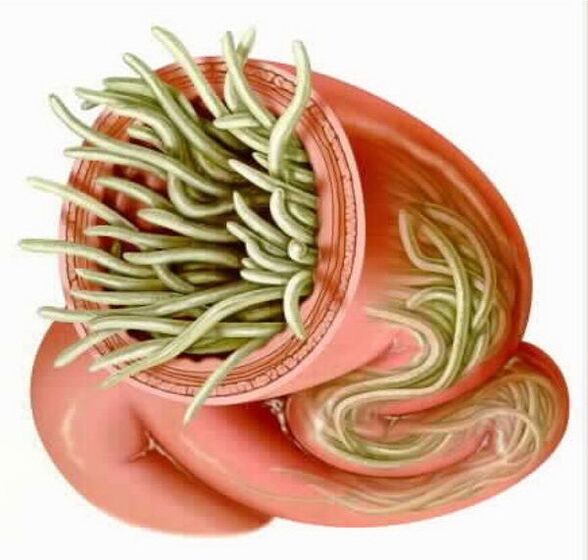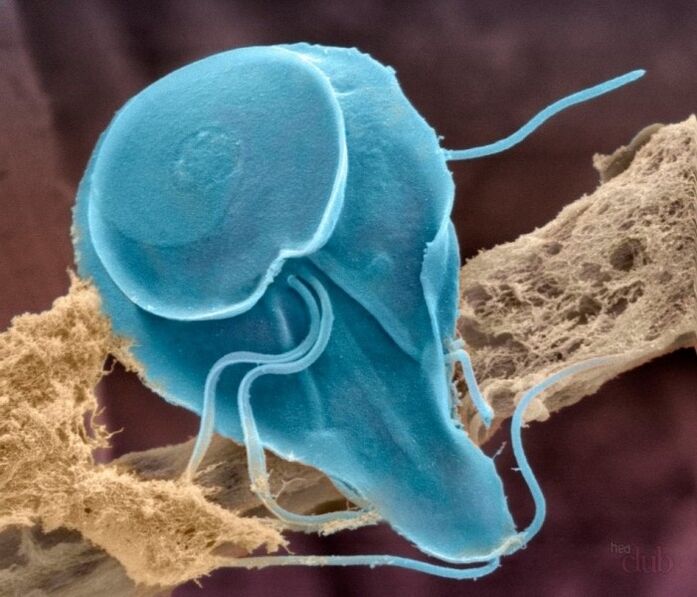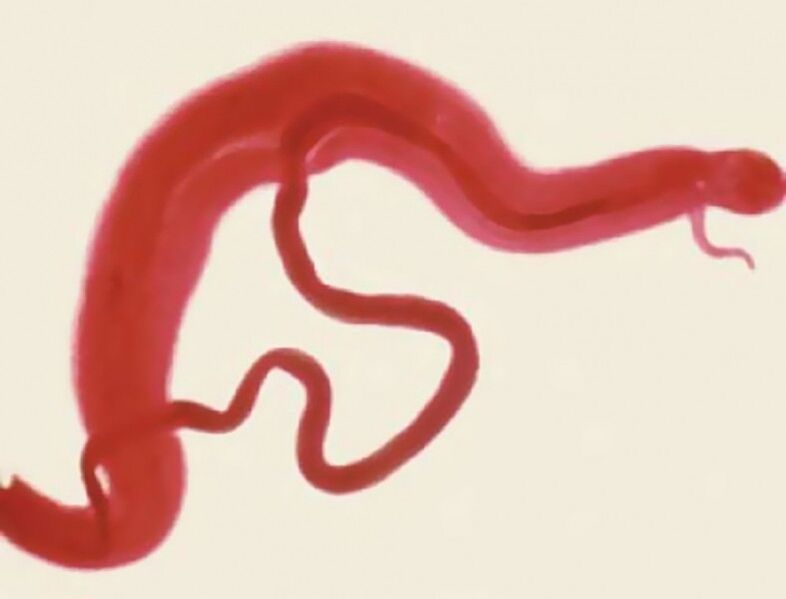Parasites in the human bodyare completely unexpected. The reason is usually direct contact with the source of infection, such as direct contact with an infected person or object. There are many types of parasites that can settle in the human body: they can be lambia, lia, pneumococcus, trichinella, schistosome, etc.
Parasites in the human body

The structure of the human body is quite complex, and it is susceptible to various diseases and infections, infections, viruses and parasites. Parasites in the human body are microorganisms that lead to a parasitic lifestyle. They try to survive by feeding on other organisms, microorganisms, cells, etc.
Parasites in the human body are microorganisms that lead to a parasitic lifestyle, trying to survive by feeding on other organisms, microorganisms, cells, etc.
Parasites find fertile soil in human life and reproduction, causing very serious, sometimes irreparable damage to his health, destroying the body from the inside, eating it, and sometimes leading to the death of a person, orStopping the work of a single organ can also worsen a person's quality of life, frustrate, and ultimately shorten his life.
There are millions of parasites in nature. Among these animals, some parasitize only one representative of the animal world. But in nature, some species may also exist in the bodies of several animals. Which parasites live in the human body? This is a question many people ask.
There are many types of worms that can live in the human body. Some of them are very rare, while others are often settled internally and can lead to a parasitic lifestyle that lasts for decades.
Various parasites
There are several types of parasites: Parasites-parasites that live on the surface of the human body. This category includes lice, bugs, and ticks; internal parasites-parasites that affect human internal organs. In turn, they are divided into two categories: protozoa and worms.
Types of parasitic protozoa: lamblia, toxoplasma, caterpillars. These types of protozoan parasites are most common in humans.
The classification of parasites related to worms means that they are divided into three categories: nematodes; fluke ces heads.
Types of parasites in the human body
Worms
Pinworms are the most famous parasites in the intestines. Diseases caused by pinworms are called enteropathy. Not only people are tortured by it, but also the apes. Children have an increased risk of pinworms. According to various data, the degree of participation of preschool children in small bowel disease ranges from 25% to 90%. The worm spreads from one person to another. Infection occurs through shaking hands, clothing, and anything the patient touches, provided that the hands are not washed after contact and the pinworm eggs enter the mouth (this usually occurs during meals).
Flies and cockroaches can carry the eggs of these nematode worms by sowing food. Worms live in the small intestine, cecum and colon. They mate in the ileum, and then the female crawls out of the anus through the rectum and lays eggs in the anus.
Symptoms of small bowel disease are itchy anus, body poisoning (allergic reactions, exhaustion, fatigue), anemia, elevated blood eosinophil levels, insomnia and abdominal pain.In order to get rid of small intestinal helminthiasis, anthelmintics are used. The dosage and duration of treatment are determined by the doctor. In order to avoid re-infection, it is important to keep your hands clean, wash your hands before eating in any public place, after use in the bathroom, etc.
Nails should be cut short, the bed and underwear should be thoroughly disinfected, and the apartment should be cleaned daily.
Tosokara
Toxoplasma gondii is a parasite of nematodes. The disease caused by toxoplasma gondii is called "toxoplasmosis". This attack on humans can be larvae (eyes and internal organs) and intestinal tract. The disease spreads widely all over the world. When worm eggs enter the human digestive tract, toxoplasma infection occurs. This is most common when eating food or water contaminated with dog feces. Contact with sick animals is equally dangerous.
Toxoplasmosis can be suspected by swollen lymph nodes: the visceral form of toxoplasmosis is the most common and occurs from damage to internal organs (intestines, respiratory system, heart valves).
A person may experience abdominal pain, right lower cartilage, indigestion, and nausea. If the respiratory system is damaged, the person has shortness of breath, dry cough, and suffocation; if the toxin deposits on the heart valve, it means that the patient is weak, the fingers are blue, the nasolabial triangle, and the breath is fast; the skin form is characterized by itching, under the skinInflammation of the skin and mucous membranes; in the form of the nervous system, the parasite stimulates inflammation of the meninges and brain tissue itself.
It manifests as headache, nausea and vomiting, seizures and other neurological diseases. In order to treat toxoplasmosis, anthelmintics and pathogenic and symptomatic treatments are used.
Human A worm disease
Human A worms are roundworms that parasitize the small intestine. The diseases caused by these parasites are called as worms. The owner of the worm and the source of infection is a patient. The eggs of the worms enter the soil along with their feces, where they mature into larvae. This soil is then transferred to food or human hands, and if the rules of personal hygiene are not followed, and if fruits, vegetables and berries are not processed properly, it is transferred to the digestive tract.
Children and rural residents are more susceptible to infection. Insect diseases manifest themselves in different stages of their development in different ways. During the migration stage of the larvae through the human body, the body temperature rises, a dry cough occurs, gasps in the lungs, and lymph nodes swell. Children are more susceptible to assimilation than adults.
Allergic skin reaction is a typical symptom of asimiasis. During the period of intestinal parasitism, patients will develop dyspeptic diseases, stool will be replaced by constipation, abdominal pain, nausea and vomiting will often occur. In part of the nervous system, hysterical convulsions, insomnia, mental fatigue and headaches were observed.
In order to treat ass worm disease in the migration stage of larvae, patients need to take some deworming drugs, and other worms are parasitic in the intestine.
hookworm and nekator
Hookworms and nekator are two types of roundworms in the family two insects. They cause a disease called hookworms. There are two ways to infect the human body through these parasites-feces-oral cavity (drinking contaminated water, fruits, vegetables) and transdermal contact with soil (penetrating the skin).
Clinical symptoms of ankylosing joint disease: papular papules, shortness of breath and cough, loss of appetite, nausea, abdominal pain, loose stools, iron deficiency anemia. The treatment is reduced by taking anthelmintics and iron preparations to eliminate anemia.
Wide ribbon
The wide tapeworm refers to the tapeworm of the pseudoalgae family. These parasites live in the small intestines of humans and fish-eating mammals. Infection with tapeworms can cause the development of diseases, such as dilobite flagellosis.
There are 12 kinds of worms that can be parasitic in the human body, but the widest tape worm is the most common. Infections can occur from eating raw and unheated shallow salted fish or caviar (which contains worm eggs). Symptoms of parasites in the intestines: nausea, abdominal pain, anemia.
In severe cases, intestinal obstruction can occur. In order to get rid of the parasites, antiparasitic drugs were prescribed for the patients. After the treatment process is completed, a second study must be conducted to find the worm in the body. If necessary, re-use anthelmintics.
Bull tapeworm
Bull tapeworm is a tapeworm belonging to the teniid family. In the larval stage, it affects cattle, while in the tapeworm stage, it lives in the human body (intestine). Tapeworms can cause a disease called teniarinhoz. Usually, a parasite is present in the patient's body. After eating unheated meat (beef), humans can become infected through diet.
Clinically, the disease is manifested as nausea, excessive appetite, abdominal pain, unstable stool and urticaria type allergic reactions. In order to remove cattle tapeworms from the body, insect repellents are required. At the same time, patients should adhere to a scum-free diet, wash enema, and take laxatives. After using insect repellent, the worms die naturally and leave the body. Sometimes its length can reach 12m.
Pork tapeworm
Pork tapeworm is a parasitic tapeworm that infects mammals. The intermediate carriers can be pigs, dogs, rabbits, and camels, but the ultimate owners are always humans.
If adult parasites are found in the human body, then they are talking about diseases such as tendinitis. When the parasite is in the patient's body during the larval stage, the disease is called "cysticercosis. "
When eating unheated pork, pork tapeworm infection occurs. Sometimes the source of cysticercosis is seeding hands or watering. A patient with tendinitis poses an epidemiological risk to himself (larval infection of the brain, skin, eyes or skeletal muscle) and others.
Symptoms of tendinitis: abdominal pain, loss of appetite, uncomfortable stool, headache, frequent dizziness, fainting (tendinopathy of the brain and eyes is very dangerous). To treat tenosynovitis, the patient was placed in a hospital. Under the supervision of a doctor, he was prescribed an anthelmintic. After 2 hours, the patient took normal saline to get rid of the worm segments and eggs. In order to treat cysticercosis of the eyes and brain, surgical intervention is necessary.
Echinococcus
Echinococcus is a tape insect from Cyclophyllidae. Adults parasite in the intestines of dogs and cats, and are found in wolves and wolves. For humans, parasite larvae are dangerous, and it can cause a serious disease-hydatid. The larvae can infect human internal organs and form echinococcal oc sacs. For echinococcosis, humans act as intermediate hosts.
Infection is carried out through contact (during the cutting of the carcass, when interacting with sick animals) or eating (when eating contaminated food or water). People engaged in animal husbandry or constant contact with animals are at risk. The symptoms may not appear for many years.
When the asymptomatic phase is over, pain, itching and urticaria will appear at the larvae’s infestation site. In addition, the function of the organs parasitized by Echinococcus e larvae is impaired. An increase in body temperature and fever was observed during the purulent period of the cyst.
Echinococcus can be completely cured only through surgery. The cyst is peeled, being careful not to damage its membrane. If the bladder is large, pierce it and suck out its contents. Before and after the operation, the patient needs to take antiparasitic drugs. In the case of radical resection of the cyst, the prognosis of recovery is good.
Pneumococcal
Pneumococcus is a worm from the tail est class. The worm can cause life-threatening alveolar disease, which is characterized by the formation of major lesions in the liver, followed by the spread of metastases to other organs. When the parasite's cancer ball enters the mouth, infection occurs.
This can happen during hunting, during the cutting of wild animal carcasses, during contact with domestic animals, or when eating unprocessed berries and herbs in the forest. Symptoms of alveolar coccosis are reduced to pain, gas, and nausea in the lower right cartilage. Frequent itching and allergic reactions. The suppuration of tumors with parasites and their penetration into the abdominal or pleural cavity are not excluded.
Alveolar cocci metastasis can be seen in the brain and lungs. The treatment of this disease is rapid, but antiparasitic drugs should be supplemented.

Giardia
Giardia (another name for Giardia) is a flagella parasite belonging to the Diplomonadid order. Giardia can cause a disease called "giardiasis" and parasitize the small intestine of humans and many other mammals and even birds.
Giardia infections occur through the fecal-oral route: food, water, and household contact methods. As far as the spread of infection is concerned, the most important thing is the use of raw water, contaminated food and the use of public goods inoculated with Lambert’s cyst. The main symptoms of giardiasis are nausea, abdominal pain, poor bowel movements and excessive gas.In addition, patients may also experience allergic reactions, poisoning and neurological diseases. The treatment of giardiasis is carried out with the help of antiprotozoal drugs, and enzymes, bile drugs and intestinal absorbers are added to the treatment plan.
Tissue amoeba
Histological amoeba is a protozoan parasite that causes a disease called amoebiasis. The disease manifests as the formation of ulcers in the large intestine and subsequent damage to other internal organs. After mature cysts from water or food enter the human gastrointestinal tract, amoeba infection occurs through the fecal-oral route. Possible spread of parasites without washing hands. Flies can be carriers of amoeba.
Another way to spread amoebiasis is through sexual (anal sex). Symptoms of amebiasis: mucus in stool, abdominal pain, blood in the stool, weight loss, anemia. In addition, parenteral amoebiasis is characterized by the formation of abscesses in those organs affected by parasites (lung, brain, liver, etc. ).
Prescribed antiprotozoal drugs to treat intestinal ambiguity.
The duration of treatment depends on the severity of amoebiasis.
A disease called keratocytosis is caused by nematode Clostridium spp. larvae and sexually mature nematodes. Infections can occur when eating unprocessed fish, frog or poultry meat, and drinking uncoiled, uncontaminated water. The symptoms of the disease are cough and pain caused by larvae penetrating the subcutaneous area, local inflammation and elevated body temperature.
is typically severe edema and itching. Usually, the symptoms disappear a week after the onset of symptoms, but they recur over the years. Harm to the eyes and brain, usually fatal. Treatment includes taking anthelmintics and surgery. During the operation, the parasites were removed from under the skin.
Trichinella
Trichinella spiralis are round parasites that live in the muscles (eye movement, chewing, muscle) in the larval stage and the small intestinal cavity in the adult stage. The disease caused by Trichinella spiralis is called "Trichinellasis". This is fatal.Human infections occur through the consumption of raw or poorly processed meat from wild and domestic animals. Symptoms include loss of appetite, vomiting, diarrhea and abdominal pain. In the future, muscle pain, swelling of the eyelids and rashes will also occur. Parasite treatment is carried out with the help of anthelmintics. At the same time, prescribe antihistamines and use corticosteroids as needed.
Schistosoma
Schistosoma is a fluke of the genus fluke. They caused a disease called schistosomiasis. Human infections occur during bathing, washing clothes or watering the ground with schistosome larvae. They can even penetrate into the body through intact skin and mucous membranes. The symptoms of the acute phase of the disease include elevated temperature, itchy skin, and pimples all over the body.
They can even penetrate into the body through intact skin and mucous membranes. The symptoms of the acute phase of the disease include elevated temperature, itchy skin, and pimples all over the body.
After the disease becomes a chronic disease, the infected person may develop symptoms such as vaginitis, prostatitis, colitis, ascites, and hydronephrosis. Use anthelmintics to treat the disease. The complications of urogenital schistosomiasis require surgical intervention.
There are many parasites that can harm the human body. If safe food preparation techniques are not followed and basic hygiene procedures are not followed, most people will enter the owner's body through the gastrointestinal tract.
Endoparasites-Adaptability
- Long life expectancy (worms have lived in the human body for many years, sometimes even as long as the host of the parasite);
- The ability to suppress or change the immune response of the host organism (the appearance of an immunodeficiency state, create conditions for pathogens to penetrate from the outside, and "inhibit" the internal lesions of the infection);
- Many types of worms release anti-enzymes after entering the digestive tract, thereby preventing them from dying; the digestive process is interrupted and toxic allergic reactions of various severity occur: urticaria, bronchial asthma, atopic dermatitis;
- Development stage (egg, larva, owner change); The ability of eggs to survive for several years in the external environment; Sexual reproduction, in which the exchange of genetic information has occurred, is the highest stage of development, leading to an increase in heterogeneous populations, that is, parasites become less vulnerable;
- Lack of immune methods, because the immune response is weak and unstable;
- Worms are widespread in many habitats (water, soil, air, plants and animals).
Prevent internal parasites
Preventive measures to prevent parasite infestation should be comprehensive. First of all, you must follow the basic rules of personal hygiene, eat only washed fruits, vegetables, and heat-treated fish and meat, and drink only clean water.
Most experts advocate the use of antiparasitic drugs to prevent helminthiasis-a parasitologist will help you choose the necessary drugs and calculate the correct dosage.
You can supplement this remedy with folk remedies that repel insects, for example, eat more onions, garlic, various spices, and eat pumpkin seeds regularly.

























